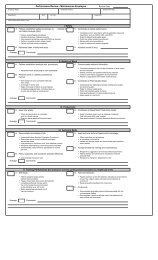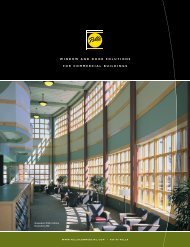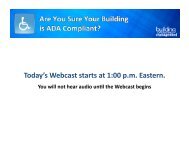Building Operating Management September 2011 - FacilitiesNet
Building Operating Management September 2011 - FacilitiesNet
Building Operating Management September 2011 - FacilitiesNet
You also want an ePaper? Increase the reach of your titles
YUMPU automatically turns print PDFs into web optimized ePapers that Google loves.
ating at less than 100 percent outside air.<br />
The pressure characteristics are typically<br />
such that a slight opening in the return<br />
air damper translates to a significant<br />
amount of airflow. Command your return<br />
dampers closed, and verify that they<br />
close completely by feeling for leakage. If<br />
they’re not closed completely, adjust the<br />
actuator/linkage connection. When closing<br />
the return dampers, be sure the outside<br />
air dampers are open, to prevent the<br />
plenum walls from collapsing inward.<br />
• Worn blade and jamb seals. Blade<br />
and jamb seals help reduce damper<br />
leakage when the damper is closed. With<br />
no seals, leakage can be as much as 10<br />
percent of rated damper airflow. Inspect<br />
your blade and jamb seals for leaks by<br />
feeling around the damper blades when<br />
they’re closed, and if your dampers don’t have seals, consider<br />
installing them as a way to increase the efficiency<br />
of your system through reduced return damper leakage<br />
during 100 percent outside air mode.<br />
• Sensors out of calibration. Temperature and enthalpy<br />
sensors are prone to drift out of calibration, especially enthalpy<br />
sensors. It’s important to keep the outside air and<br />
return air sensors calibrated, as these are typically the<br />
sensors that make the determination for the economizer<br />
operating mode. Developing and implementing a sensor<br />
calibration program can help keep these sensors calibratbuildingoperatingmanagement<br />
SEPTEMBER <strong>2011</strong><br />
85<br />
DAVE MOSER<br />
tem uses enthalpy sensors, evaluate the energy benefits<br />
against the added operation and maintenance costs of<br />
maintaining the calibration of these sensors.<br />
• Oversized return air dampers. For proper control, return<br />
air dampers need adequate air velocity across them.<br />
This is especially true for systems that<br />
use return fans instead of relief fans.<br />
Measure the air velocity across the return<br />
air damper during minimum outside<br />
air mode, when the return air dampers<br />
are 100 percent open. If it’s much less<br />
than 1,500 fpm (a rule of thumb), consider<br />
blanking off some of the return air<br />
dampers to increase performance.<br />
• Inadequate building pressure relief.<br />
During economizer operation, adequate<br />
pressure relief must be available to avoid<br />
building over-pressurization issues such<br />
as doors standing open and reduced<br />
supply airflow. Measure the difference<br />
between the indoor and outdoor pressure<br />
during economizer operation. If the<br />
difference is much greater than a tenth of<br />
an inch, investigate the relief air system<br />
to see if it has an adequate airflow path<br />
and that it’s controlling properly.<br />
• Poor sensor placement. Temperature and enthalpy<br />
sensor placement is crucial for proper economizer operation.<br />
Verify that the outside air sensor is in a good, representative<br />
location (i.e., never in direct sun, not too close<br />
to air outlets), and make sure the mixed air sensors are<br />
located correctly as well (e.g., in a place with good mixing).<br />
Averaging sensors are the best choice for mixed air<br />
temperature.<br />
According to a PECI study on existing building commissioning,<br />
air handlers typically have more performance<br />
issues than any other type of equipment. There are many<br />
An air handler<br />
requires a lot of<br />
maintenance,<br />
and this work,<br />
important as it<br />
is, can easily be<br />
overlooked or<br />
deferred<br />
aspects to maintain on an air handler, and this maintenance<br />
can easily be overlooked or deferred. The <strong>Building</strong><br />
Owner and Managers Association’s (BOMA’s) recently updated<br />
preventive maintenance guide, “Preventive Maintenance:<br />
Best Practices to Maintain Efficient and Sustainable<br />
<strong>Building</strong>s,” suggests preventive maintenance tasks<br />
for air handlers, which include quarterly and semiannual<br />
preventive maintenance tasks for maintaining the performance<br />
of airside economizer systems. Here are some<br />
common maintenance-related issues and periodic tests<br />
that can be done to address and avoid performance problems<br />
with air-handling units.<br />
• Stuck dampers or broken linkages. Economizer<br />
dampers, especially outside air dampers, can seize in<br />
place due to entrained debris and humid conditions. This<br />
is especially an issue for salty, corrosive marine environments.<br />
Also, the linkages, which connect the actuator to<br />
the damper, can fail. Cycle your dampers open and closed<br />
periodically, and verify that they operate as intended. This<br />
often requires one person at the control system’s operator<br />
workstation, and another person observing damper<br />
operation. When the damper is commanded open, does<br />
it actually open? Don’t just rely on the output signal from<br />
the operator workstation as the final word in how a system<br />
is actually working.<br />
• Actuators not adjusted for full closure. A slight opening<br />
in the “closed” return air dampers during integrated<br />
economizer and mechanical cooling mode (100 percent<br />
outside air) can significantly reduce the efficiency of the<br />
system due to increased mechanical<br />
cooling load, because the system is oper-





